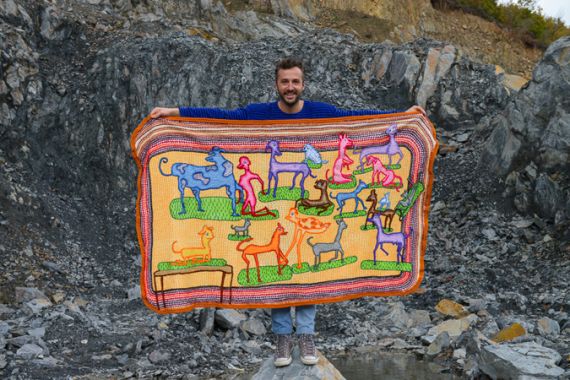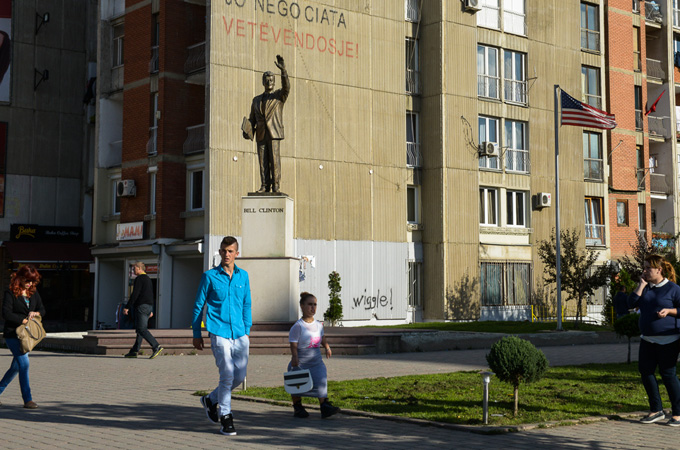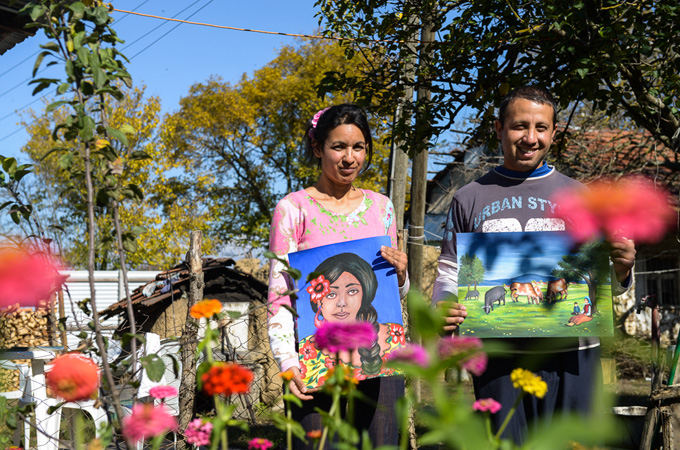Art of change in post-war Kosovo
Many artists are using their work to raise social, economic, and political issues in Kosovo post independence.

Pristina, Kosovo – The female artists never thought people would threaten to behead them for sharing a kiss in this city’s main square and putting a photo of it on Facebook.
“We were very scared when we got death threats,” Hana Qena, 26, said nervously. “That’s when we realised we’d done something very provocative.”
Keep reading
list of 4 items‘Accepted in both [worlds]’: Indonesia’s Chinese Muslims prepare for Eid
Photos: Mexico, US, Canada mesmerised by rare total solar eclipse
What is a Godzilla anyway? The 70-year-old monster behind the movies
Hana is part of the Haveit Collective – an art group comprised of a pair of sisters in Kosovo, the southeast European country that declared independence in 2008, but is still fighting for complete international recognition. Serbia continues to claim it as part of its territory.
Hana’s sister Vesa Qena, 23, is also part of the group, along with two other sisters – 26-year-old Lola Sylaj and Alketê, 23.
Last Valentine’s Day, the Haveit Collective attracted attention to their performance in Kosovo’s capital, Pristina, when they decided to kiss each other and then uploaded the photos to their Facebook profile.
When Kosovo fell under direct Serbian administration in the 1990s, art and art institutions weren't accessible for Kosovar Albanians - the majority of the population.
Although homosexuality is legal in Kosovo, there is stigma attached to the lesbian, gay, bisexual, transgender (LGBT) community here.
After the performance, the group was taken in for interrogation by police but eventually set free after they said they weren’t lesbians. The four women went home thinking they would get a few “Likes” on Facebook, that’s all.
“When we woke up the next day, we were shocked. The photo had gone viral and we received over 100 death threats,” Hana told Al Jazeera.
Vesa – quieter and more reserved of the two – added: “People with extreme religious views wrote in saying they would behead us,” gesturing with her finger across her throat.
Kosovo – where a bloody one-year-long war ended in 1999 – has a predominantly Albanian-Muslim population.
“With the performance we challenged people’s religious ideas here. They were upset. LGBT rights are not really spoken about here,” Lola said.
Art and intervention
The Haveit Collective – like many other independent artists in Kosovo – is using art to raise social and political issues in the country. In the three years since it organised, the collective has held street interventions about domestic violence, suppression of LGBT rights, and extreme nationalism.
Albert Heta – co-founder of Stacion – Center for Contemporary Art Prishtina, an independent culture institution – said Kosovo’s art scene has slowly emerged since the war.
“When Kosovo fell under direct Serbian administration in the 1990s, art and art institutions weren’t accessible for Kosovar Albanians – the majority of the population,” Heta said. “It was during this time that the idea of a contemporary art scene started to develop, but it happened under a very restrictive environment. After the war, this scene continued but more openly.”
Heta said art in Kosovo now is more than just pretty pictures. “Today, art or artists are not here just to decorate this society, but also to reflect and criticise,” he said.
 |
| Kosovars walk past a statue of the former US president on Bill Clinton Boulevard in Pristina [Felix Gaedtke/Al Jazeera] |
Kosovo is one of Europe’s poorest countries. It suffers from an unemployment rate of about 45 percent, and people here earn an average salary of just $20 a day.
Kosovo is also dogged by a political stalemate as the Democratic Party of Kosovo, which won the most seats in the June elections, has failed to form a coalition government.
Cultural transformation
Alban Muja, 34, is a visual artist and film-maker who grew up in Pristina. He met with Al Jazeera at a popular cafe. “As an artist I am always trying to research how social, political and cultural transformation is going on in the region,” Muja said, puffing on a cigarette.
One of Muja’s important works is a documentary titled Blue wall red door . “The film is about how people in Pristina don’t use street names. Why? Because in the last 20 years, they changed the name of the streets five to six times depending on who’s in power,” he said.
Muja is one of the few Kosovar artists to have travelled around the world with his work. “What you learn while travelling, no school can teach you. But unfortunately, most artists here can’t travel freely because of restrictive visa policies,” said Muja.
According to the latest visa restrictions index, Kosovo ranks 80th alongside Iran and the Democratic Republic of Congo. Invariably, every Kosovar artist laments about the troubles faced while trying to acquire visas.
Conceptual artist Flaka Haliti currently explores the topic in an artwork at the National Art Gallery in Pristina.
On a massive glass installation, Haliti etches in bold a fictitious resolution by UNESCO to allow free global movement of artists.
” It’s a lie that UNESCO is finally giving immunity to artists wanting to live and travel abroad,” she told Al Jazeera on the opening evening of her exhibition. “I don’t want to give hope to some artists who are desperate to get this. But I am trying to communicate to people who never think about these issues.”
Minority art
 |
| Farija and Bajram Mehmeti [Felix Gaedtke/Al Jazeera] |
For other artists such as Bajram and Farija Mehmeti, being recognised is itself a big challenge. The minority Roma siblings live modestly in Lepina – a small village about a half hour’s drive from Pristina.
Roma along with Serbs are among the most discriminated groups in Kosovo. After the war, Roma who continued to live in Kosovo were placed in camps spread out across the country.
Bajram and Farija go about their daily routine like any other villagers – collecting wood for the household, working on the farm, and other household chores. When they get time off, they get on with their art.
“Our art is inspired by the Roma way of life, what we see around us. I paint landscapes and sceneries and my sister does portraits,” Bajram, 34, said shyly. The siblings proudly led Al Jazeera to their studio – a hut with many finished and some incomplete canvases.
Farija, 36, showed her portraits one after the other. Each depicted a Roma woman dressed in traditional clothes and accessories. “One is for 50 euros [$64],” she said sounding disappointed.
Her younger brother jumped into the conversation. “We can’t really live off our work… It’s very hard for us to survive just with our art.”
Back in Pristina, a Roma film festival “Rolling Films” opened at the National Theatre. Sami Mustafa, a 28-year-old Roma documentary film-maker, echoed Bajram’s words. “It is hard and challenging to survive as a film-maker in Kosovo. But as a Roma film-maker, it’s double as hard and challenging,” he said.
Mustafa pointed out a majority of the Roma community in Kosovo suffer from abject poverty. “It’s very hard to inspire youngsters to participate in art when there’s no real monetary incentive. We try but it’s really difficult.”
With music you can influence people, but it's hard to affect change. The best way to change things is to get involved in politics.
Old school art
Despite a growing and diverse art scene, Kosovar artists also face archaic practises.
“The art institutions in the country aren’t up to date,” said Lulzim Zeqiri, 35. “I studied painting at the Faculty of Art in Pristina, but I wouldn’t go there again because the way they perceive art there is very rigid. There are also very few spaces in Kosovo for independent and alternative art to flourish.”
Kosovo’s Minister for Culture, Youth and Sport Memli Krasniqi told Al Jazeera many of the artists’ complaints were valid.
“Firstly, I think that young artists need to complain. They have to. It is true that we lack cultural infrastructure, but I’m happy to say that we’ve tripled the budget for the public as well as the private art scene. I am aware that it’s still not enough and we’re working on that,” Krasniqi said at his office.
Krasniqi himself was a rapper before stepping into politics. It might seem like a strange career shift, but Krasniqi disagreed.
“My music and lyrics were political, social and very rebellious in a way… With music you can influence people, but it’s hard to affect change. The best way to change things is to get involved in politics.”
Internationally acclaimed painter Jakup Ferri said he doesn’t want people only to think about war when Kosovo is mentioned. “We need to talk beyond nationalism, beyond borders, and think as citizens of this world,” said Ferri.